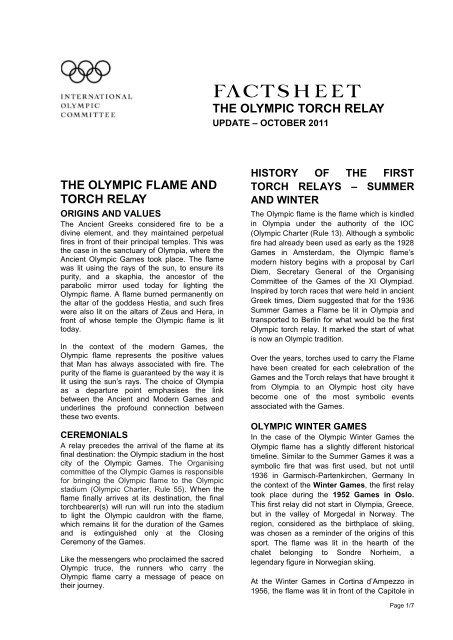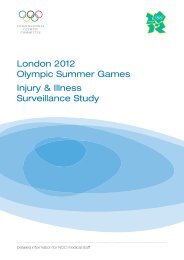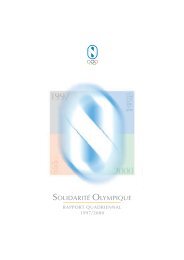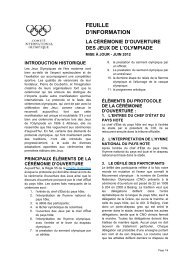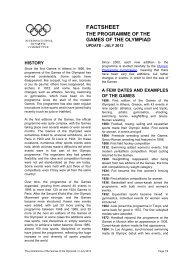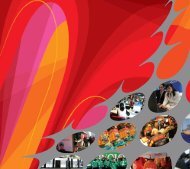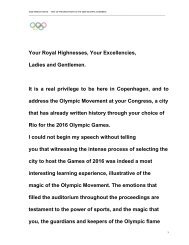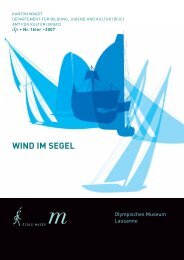The Olympic torch relay - International Olympic Committee
The Olympic torch relay - International Olympic Committee
The Olympic torch relay - International Olympic Committee
Create successful ePaper yourself
Turn your PDF publications into a flip-book with our unique Google optimized e-Paper software.
THE OLYMPIC FLAME AND<br />
TORCH RELAY<br />
ORIGINS AND VALUES<br />
<strong>The</strong> Ancient Greeks considered fire to be a<br />
divine element, and they maintained perpetual<br />
fires in front of their principal temples. This was<br />
the case in the sanctuary of Olympia, where the<br />
Ancient <strong>Olympic</strong> Games took place. <strong>The</strong> flame<br />
was lit using the rays of the sun, to ensure its<br />
purity, and a skaphia, the ancestor of the<br />
parabolic mirror used today for lighting the<br />
<strong>Olympic</strong> flame. A flame burned permanently on<br />
the altar of the goddess Hestia, and such fires<br />
were also lit on the altars of Zeus and Hera, in<br />
front of whose temple the <strong>Olympic</strong> flame is lit<br />
today.<br />
In the context of the modern Games, the<br />
<strong>Olympic</strong> flame represents the positive values<br />
that Man has always associated with fire. <strong>The</strong><br />
purity of the flame is guaranteed by the way it is<br />
lit using the sun‟s rays. <strong>The</strong> choice of Olympia<br />
as a departure point emphasises the link<br />
between the Ancient and Modern Games and<br />
underlines the profound connection between<br />
these two events.<br />
CEREMONIALS<br />
A <strong>relay</strong> precedes the arrival of the flame at its<br />
final destination: the <strong>Olympic</strong> stadium in the host<br />
city of the <strong>Olympic</strong> Games. <strong>The</strong> Organising<br />
committee of the <strong>Olympic</strong> Games is responsible<br />
for bringing the <strong>Olympic</strong> flame to the <strong>Olympic</strong><br />
stadium (<strong>Olympic</strong> Charter, Rule 55). When the<br />
flame finally arrives at its destination, the final<br />
<strong>torch</strong>bearer(s) will run will run into the stadium<br />
to light the <strong>Olympic</strong> cauldron with the flame,<br />
which remains lit for the duration of the Games<br />
and is extinguished only at the Closing<br />
Ceremony of the Games.<br />
Like the messengers who proclaimed the sacred<br />
<strong>Olympic</strong> truce, the runners who carry the<br />
<strong>Olympic</strong> flame carry a message of peace on<br />
their journey.<br />
THE OLYMPIC TORCH RELAY<br />
UPDATE – OCTOBER 2011<br />
HISTORY OF THE FIRST<br />
TORCH RELAYS – SUMMER<br />
AND WINTER<br />
<strong>The</strong> <strong>Olympic</strong> flame is the flame which is kindled<br />
in Olympia under the authority of the IOC<br />
(<strong>Olympic</strong> Charter (Rule 13). Although a symbolic<br />
fire had already been used as early as the 1928<br />
Games in Amsterdam, the <strong>Olympic</strong> flame‟s<br />
modern history begins with a proposal by Carl<br />
Diem, Secretary General of the Organising<br />
<strong>Committee</strong> of the Games of the XI Olympiad.<br />
Inspired by <strong>torch</strong> races that were held in ancient<br />
Greek times, Diem suggested that for the 1936<br />
Summer Games a Flame be lit in Olympia and<br />
transported to Berlin for what would be the first<br />
<strong>Olympic</strong> <strong>torch</strong> <strong>relay</strong>. It marked the start of what<br />
is now an <strong>Olympic</strong> tradition.<br />
Over the years, <strong>torch</strong>es used to carry the Flame<br />
have been created for each celebration of the<br />
Games and the Torch <strong>relay</strong>s that have brought it<br />
from Olympia to an <strong>Olympic</strong> host city have<br />
become one of the most symbolic events<br />
associated with the Games.<br />
OLYMPIC WINTER GAMES<br />
In the case of the <strong>Olympic</strong> Winter Games the<br />
<strong>Olympic</strong> flame has a slightly different historical<br />
timeline. Similar to the Summer Games it was a<br />
symbolic fire that was first used, but not until<br />
1936 in Garmisch-Partenkirchen, Germany In<br />
the context of the Winter Games, the first <strong>relay</strong><br />
took place during the 1952 Games in Oslo.<br />
This first <strong>relay</strong> did not start in Olympia, Greece,<br />
but in the valley of Morgedal in Norway. <strong>The</strong><br />
region, considered as the birthplace of skiing,<br />
was chosen as a reminder of the origins of this<br />
sport. <strong>The</strong> flame was lit in the hearth of the<br />
chalet belonging to Sondre Norheim, a<br />
legendary figure in Norwegian skiing.<br />
At the Winter Games in Cortina d‟Ampezzo in<br />
1956, the flame was lit in front of the Capitole in<br />
Page 1/7
Rome, as the city had been elected host of the<br />
Games of the XVII Olympiad. <strong>The</strong> tripod used<br />
for the ceremony was sent from Olympia. At the<br />
Winter Games in Squaw Valley in 1960, the<br />
flame was once again lit in Norway, at Sondre<br />
Norheim‟s chalet. <strong>The</strong> inscription on the <strong>torch</strong><br />
“Olympia to Squaw Valley” is a reference to an<br />
attempt to start the <strong>relay</strong> in Olympia, which did<br />
not succeed as the time period was too<br />
restricted. Since the Innsbruck Games in 1964,<br />
the <strong>relay</strong> for the Winter Games has begun in<br />
Olympia.<br />
<strong>The</strong> arrival of the <strong>Olympic</strong> flame at the Opening<br />
Ceremony of the Games in Turin in 2006 was<br />
much more than a protocol element indicating<br />
the start of a new edition of the Games. It also<br />
represented the end of a unique journey.<br />
Carried over 11,000 kilometres, the flame<br />
travelled through all the Italian provinces, Sicily<br />
and Sardinia, and also in San Marino before<br />
going back to the Alps and making a symbolic<br />
diversion through the French towns of Grenoble<br />
and Albertville, which hosted the Games in 1968<br />
and 1992. <strong>The</strong> <strong>torch</strong> <strong>relay</strong> also visited the alpine<br />
countries of Slovenia, Austria, and Switzerland.<br />
ITINERARY OF THE RELAY - BASIC<br />
ROUTE<br />
Choosing a route for a <strong>relay</strong> is not as easy as<br />
drawing a straight line between Olympia and the<br />
<strong>Olympic</strong> stadium of the host city of the Games!<br />
Each <strong>relay</strong> has its own “flavour” and enables<br />
people from all over the world to discover the<br />
history and culture of the host city and country.<br />
From Olympia to Athens … the organisation of<br />
the lighting of the flame in Olympia is always<br />
handled by the Hellenic <strong>Olympic</strong> <strong>Committee</strong><br />
(HOC). This <strong>Committee</strong> also organises the<br />
transport of the flame by runners to Athens or,<br />
more precisely, to the ancient Panathinaiko<br />
stadium which was used for the 1896 Games.<br />
From Athens to the host city… the rest of the<br />
<strong>relay</strong> to the host city of the Games is handled by<br />
the <strong>Olympic</strong> Games Organising <strong>Committee</strong><br />
(OCOG). <strong>The</strong> <strong>Committee</strong> chooses the theme<br />
and vision of the <strong>relay</strong>, which helps them<br />
determine the cities towns, regions and<br />
monuments to be visited and the different<br />
modes of transport. <strong>The</strong> following are some<br />
examples of themes which have influenced the<br />
itineraries of the flame.<br />
THEMATIC ROUTES – SOME<br />
EXAMPLES OF SIGNIFICANT<br />
RELAYS<br />
<strong>The</strong> <strong>relay</strong> of peace – London 1948<br />
In a Europe sorely afflicted by the war, the 1948<br />
<strong>relay</strong> carried a welcome message of peace. <strong>The</strong><br />
first runner, Corporal Dimitrelis, took off his<br />
military uniform before carrying the flame,<br />
commemorating the sacred truce observed in<br />
Ancient Greece. <strong>The</strong> planned route highlighted<br />
border crossings, where festivities were<br />
organised to celebrate the return of peace. In<br />
homage to the restorer of the <strong>Olympic</strong> Games,<br />
the <strong>relay</strong> passed through Lausanne, Switzerland<br />
and a ceremony was organised at Pierre de<br />
Coubertin‟s tomb in the Bois-de-Vaux cemetery.<br />
<strong>The</strong> ancient Relay – Rome 1960<br />
<strong>The</strong> <strong>relay</strong> shone the spotlight on the two poles<br />
of classical civilisation: Athens and Rome.<br />
Lesser-known ancient sites in Greece and Italy<br />
were thus brought to the public‟s attention. For<br />
the first time, the <strong>relay</strong> was televised and the<br />
event closely followed by the media.<br />
<strong>The</strong> <strong>relay</strong> to the New World – Mexico City<br />
1968<br />
<strong>The</strong> <strong>relay</strong> retraced the steps of Christopher<br />
Columbus to the New World. <strong>The</strong> idea was to<br />
underline the link between Mediterranean and<br />
Latin-American civilisations and between<br />
ancient (Greco-Latin) and Pre-Hispanic<br />
civilisations. A direct descendant of the great<br />
navigator, Cristóbal Colón de Carbajal, was the<br />
last runner on Spanish soil. <strong>The</strong> <strong>Olympic</strong> flame<br />
made a stop at the Great Pyramid of the Moon<br />
in Teotihuacan. A “New Fire” ceremony was<br />
organised which, in the Aztec tradition, was<br />
celebrated to mark the end of a 52-year cycle.<br />
<strong>The</strong> reappearance of the sun at dawn<br />
symbolised the renewal of the world.<br />
<strong>The</strong> Korean <strong>relay</strong> “Harmony and progress”–<br />
Seoul 1988<br />
<strong>The</strong> <strong>relay</strong> showcased the traditions of Korea. Its<br />
route, which was a zigzag from east to west,<br />
symbolised the harmony to be found in the<br />
<strong>The</strong> <strong>Olympic</strong> Torch Relay / October 2011 Page 2/7
alance between two opposite poles. Some of<br />
the <strong>torch</strong>bearers did not wear the official uniform<br />
provided by the Games Organising <strong>Committee</strong>,<br />
but instead wore regional or traditional<br />
costumes.<br />
<strong>The</strong> “Down Under” <strong>relay</strong> – Sydney 2000<br />
<strong>The</strong> <strong>relay</strong> had a twofold goal: to situate Australia<br />
within Oceania and to promote the culture and<br />
heritage of the different regions in the country.<br />
<strong>The</strong> Torch <strong>relay</strong> visited 12 Oceanic countries<br />
before it arrived in Australia. <strong>The</strong> start of the<br />
<strong>relay</strong> on the Australian continent was in the “red<br />
centre” at Uluru (Ayer‟s Rock), a sacred site for<br />
the indigenous population. <strong>The</strong> Aboriginal<br />
athlete Nova Peris-Kneebone, <strong>Olympic</strong> field<br />
hockey champion, was the first runner in the<br />
<strong>relay</strong>. <strong>The</strong> enthusiasm of the crowd along the<br />
<strong>relay</strong> route grew bigger and bigger. One million<br />
spectators welcomed the arrival of the flame in<br />
Sydney. In a ceremony which recalled the<br />
elements used in the design of the <strong>torch</strong> (fire,<br />
water, earth), Cathy Freeman “walked on water”<br />
before lighting a circle of fire which revealed<br />
itself to be the monumental cauldron.<br />
ORIGINALITY OF TRANSPORTATION<br />
Traditionally, <strong>relay</strong>s have been carried out on<br />
foot (for Berlin 1936, London 1948 and Moscow<br />
1980 the <strong>relay</strong>s were entirely run in this way).<br />
Although at the beginning, runners were mainly<br />
selected from amongst athletes, gradually the<br />
general public began to participate as well. As<br />
the celebration of the <strong>Olympic</strong> Games has<br />
evolved, the <strong>Olympic</strong> <strong>torch</strong> <strong>relay</strong> also did. <strong>The</strong><br />
modes of transport have slowly become more<br />
and more diversified, not only for practical<br />
reasons, but also to showcase the particularities<br />
of the regions crossed.<br />
<strong>The</strong> flame in the snow! Legendary Norwegian<br />
skiers (or their descendants) carried out the<br />
entirety of the transport of the flame (Oslo<br />
1952). <strong>The</strong> flame went into the Arctic Circle at<br />
Inuvik, with stages carried out by snow-bike and<br />
skidoo (Calgary 1988).<br />
flame out of the water (Grenoble 1968). <strong>The</strong><br />
flame travelled on the frigate Cataluña for the<br />
passage between Greece and Spain and arrived<br />
on Spanish soil in Empuries, the gateway to<br />
Greek civilisation on the Iberian peninsular<br />
(circa 600 B.C.) (Barcelona 1992). A diver even<br />
carried the flame under water at the Great<br />
Barrier Reef (Sydney 2000). And in Venise, a<br />
Gondola was used to cross the Canal Grande<br />
(Torino 2006).<br />
<strong>The</strong> flame in the air, through the air and in<br />
space! <strong>The</strong> flame made its first trip in an<br />
aeroplane (Oslo 1952). It later traveled faster<br />
than the speed of sound on its journey from<br />
Athens to Paris – aboard the Concorde!<br />
(Albertville 1992). <strong>The</strong> wonders of technology<br />
were highlighted when the Canadians organized<br />
the transmission of the flame by satellite<br />
between Athens and Ottawa (Montreal 1976).<br />
For the first time in the history of the <strong>Olympic</strong>s,<br />
the transfer of the flame took place between two<br />
parachute jumpers (Lillehammer 1994). It also<br />
made an impressive entry at the opening<br />
ceremony of the Games, carried by a ski jumper<br />
during his actual jump! (Lillehammer 1994). <strong>The</strong><br />
<strong>torch</strong> (but not the flame) was carried into space<br />
by astronauts (Atlanta 1996 and Sydney 2000).<br />
<strong>The</strong> flame on horseback and on a camel! To<br />
mark the fact that the equestrian events were<br />
held separately from the other <strong>Olympic</strong> events,<br />
the <strong>torch</strong>bearers for the journey of the flame<br />
from Kastrup (Denmark) to Stockholm carried<br />
the flame entirely on horseback<br />
(Melbourne/Stockholm 1956). Horses played a<br />
special role again when the history of the Pony<br />
express was featured as a part of a <strong>torch</strong> <strong>relay</strong><br />
(Atlanta 1996). <strong>The</strong>y were replaced by camels<br />
when the flame crossed the Australian desert<br />
(Sydney 2000).<br />
<strong>The</strong> flame and the Wild West! For the<br />
<strong>Olympic</strong> Games in Atlanta in 1996, the modes<br />
of transport that were used bring to mind great<br />
moments in American history. For example, the<br />
flame traveled in an Indian canoe, on a<br />
<strong>The</strong> flame in the water, on the water and Mississippi steamboat, and on a wagon of the<br />
under water! In the sea off Veracruz, Mexico, Union Pacific (the first transcontinental railroad)<br />
swimmers carried the flame from the boat (Atlanta 1996).<br />
Durango to the shore (Mexico 1968). A diver<br />
swam across the port of Marseilles holding the<br />
<strong>The</strong> <strong>Olympic</strong> Torch Relay / October 2011 Page 3/7
RELAYS FACTS AND FIGURES<br />
AT A GLANCE<br />
SUMMER GAMES<br />
Berlin 1936<br />
- Number of <strong>torch</strong>bearers: 3 331.<br />
- Total distance: 3 187 km (including special<br />
stages in Kiel and Grünau).<br />
- Countries crossed: Greece, Bulgaria,<br />
Yugoslavia, Hungary, Austria, Czechoslovakia,<br />
and Germany.<br />
London 1948<br />
- Number of <strong>torch</strong>bearers: 1 416 (sources may<br />
differ).<br />
- Total distance: 3 365 km.<br />
- Countries crossed: Greece, Italy, Switzerland,<br />
France, Luxembourg, Belgium, and England.<br />
Helsinki 1952<br />
- Number of <strong>torch</strong>bearers: 3 372.<br />
- Total distance: 7 870 km (4 725 km for the<br />
overland transport).<br />
- Countries crossed: Greece, Denmark,<br />
Sweden, and Finland.<br />
Melbourne 1956<br />
- Number of <strong>torch</strong>bearers: unknown.<br />
- Total distance: 20 470 km (including air<br />
transport), distance covered on foot: 4 912 km.<br />
- Countries crossed: Greece, Australia with<br />
stopovers in Calcutta, Bangkok, Singapore, and<br />
Djakarta.<br />
Stockholm 1956 (Equestrian Games)<br />
- Number of <strong>torch</strong>bearers: 330 runners in<br />
Greece and approx. 160 horse riders in<br />
Denmark and Sweden.<br />
- Total distance: ~350 km by foot. Distance by<br />
horse uncertain.<br />
- Countries crossed: Greece, Denmark, and<br />
Sweden<br />
Rome 1960<br />
- Number of <strong>torch</strong>bearers: 1 529.<br />
- Total distance: ~2 750 km (distance covered<br />
by foot 1 863 km).<br />
- Countries crossed: Greece, Italy.<br />
Tokyo 1964<br />
- Number of <strong>torch</strong>bearers 101 866 (this high<br />
number is explained by the fact that in Japan,<br />
1km was covered by the bearer of the flame,<br />
two reserve runners and up to 20 accompanying<br />
people)<br />
- Total distance: 26 065 km (including air<br />
transport), distance covered by foot: 7 487 km.<br />
- Countries crossed: from Greece, Turkey,<br />
Lebanon, Iran, Pakistan, India, Burma, Thailand,<br />
Malaysia, Hong Kong, Taiwan. Three routes and<br />
two others flames lit with the sacred one inside<br />
Japan.<br />
Mexico 1968<br />
- Number of <strong>torch</strong>bearers: 2 778.<br />
- Total distance: 13 620 km (including transport<br />
by boat), distance covered by foot: ~2 500 km.<br />
- Countries crossed: Greece, Italy, Spain,<br />
Canary Islands, San Salvador, and Mexico.<br />
Munich 1972<br />
- Number of <strong>torch</strong>bearers: ~ 6 000.<br />
- Total distance: 5 532 km.<br />
- Countries crossed Greece, Turkey, Bulgaria,<br />
Romania, Yugoslavia, Hungary, Austria, and<br />
West Germany.<br />
Montreal 1976<br />
- Number of <strong>torch</strong>bearers: approx. 1 214.<br />
- Total distance: 775 km.<br />
- Countries crossed: Greece, Canada<br />
Moscow 1980<br />
- Number of <strong>torch</strong>bearers: ~ 5 000.<br />
- Total distance: 4 915 km.<br />
- Countries crossed: Greece, Bulgaria,<br />
Romania, and USSR.<br />
Los Angeles 1984<br />
- Number of <strong>torch</strong>bearers: 3 636.<br />
- Total distance: 15 000 km.<br />
- Countries crossed: only United States.<br />
Seoul 1988<br />
- Number of <strong>torch</strong>bearers: 20 899 (including<br />
escort).<br />
- Total distance: 15 250 (including air transport)<br />
- Countries crossed: Greece, Korea.<br />
Barcelona 1992<br />
- Number of <strong>torch</strong>bearers: 10 448 (599 cyclists)<br />
<strong>The</strong> <strong>Olympic</strong> Torch Relay / October 2011 Page 4/7
- Total distance: 6 307 km (including transport<br />
by boat).<br />
- Countries crossed: Greece, Spain.<br />
Atlanta 1996<br />
- Number of <strong>torch</strong>bearers: 12 467.<br />
- Total distance: 26 875 km.<br />
- Countries crossed: Greece, United States.<br />
In honor of the Centennial <strong>Olympic</strong> Games, the<br />
HOC held a celebration as the flame was<br />
brought into the Panathinaiko Stadium. This<br />
celebration of Greek traditions and the reenactment<br />
of the first modern <strong>Olympic</strong> Games in<br />
1896 concluded as representatives from 17<br />
cities that had previously hosted the <strong>Olympic</strong><br />
Games each received a safety lantern, lit from<br />
the sacred <strong>Olympic</strong> flame. During the next 21<br />
days, these flames were celebrated in each<br />
former host city while the original flame burned<br />
in Athens.<br />
Sydney 2000<br />
- Number of <strong>torch</strong>bearers: 800 (Greece), 1 500<br />
(Oceania), 11 000 (Australia)<br />
- Total distance: 27 000 km in Australia.<br />
- Countries crossed: Greece, Guam, Palau,<br />
Micronesia, Salomon Islands, Samoa, Cook<br />
Islands, Fiji, New Zealand, and Australia.<br />
Athens 2004<br />
- Number of <strong>torch</strong>bearers approx. 7 700<br />
(Greece), approx. 3 600 (internationally)<br />
- Total distance over 78 000 km<br />
- Countries crossed Greece, plus international<br />
route covering all five continents and visiting all<br />
previous Summer Games host cities. <strong>The</strong> Torch<br />
Relay travelled along the following route:<br />
Ancient Olympia, Athens, Sydney, Melbourne,<br />
Tokyo, Seoul, Beijing, Delhi, Cairo, Cape Town,<br />
Rio de Janeiro, Mexico City, Los Angeles, St.<br />
Louis, Atlanta, New York, Montreal, Antwerp,<br />
Brussels, Amsterdam, Geneva, Lausanne,<br />
Paris, London, Barcelona, Rome, Munich,<br />
Berlin, Stockholm, Helsinki, Moscow, Kiev,<br />
Istanbul, Sofia and Nicosia.<br />
Beijing 2008<br />
- Number of <strong>torch</strong>bearers: 21 800<br />
- Total distance: 137 000 km during 129 days.<br />
- Cities visited: Almaty, Istanbul, St. Petersburg,<br />
London, Paris, San Francisco, Buenos Aires,<br />
Dar es Salaam, Muscat, Islamabad, New Delhi,<br />
Bangkok, Kuala Lumpur, Jakarta, Canberra,<br />
Nagano, Seoul, Pyongyang, Ho Chi Minh City,<br />
Macao. <strong>The</strong> 2008 <strong>Olympic</strong> Flame also reached<br />
the summit of Mount Everest.<br />
London 2012<br />
- Number of <strong>torch</strong>bearers: 8000 (UK)<br />
- Duration 70 day, from the 19 May to the 27<br />
July 2012.<br />
<strong>The</strong> <strong>Olympic</strong> flame is lit in Ancient Olympia,<br />
Greece, and arrives in the UK on 18 May 2012.<br />
Representing peace, unity and friendship, the<br />
Flame will be carried by 8,000 inspirational<br />
Torchbearers during the <strong>Olympic</strong> Torch Relay.<br />
<strong>The</strong> London 2012 <strong>Olympic</strong> Torch Relay will<br />
focus on the nation‟s youth with a large<br />
percentage of the <strong>torch</strong>bearers being 18 years<br />
and under.<br />
As it makes its way across the UK on a 70-day<br />
journey it will bring the excitement of the Games<br />
to everyone. <strong>The</strong> <strong>Olympic</strong> Flame will travel to<br />
within an hour of 95 per cent of people in the<br />
UK, Isle of Man, Guernsey and Jersey during<br />
the 70-day <strong>Olympic</strong> Torch Relay<br />
<strong>The</strong> <strong>Olympic</strong> Torch Relay will help shine a light<br />
on the whole of the UK – from dynamic urban<br />
areas to places of outstanding natural beauty.<br />
Evening celebrations in towns and cities will<br />
show off the best of the local area, bringing<br />
people together to mark the <strong>Olympic</strong> Flame's<br />
arrival.<br />
Coca-Cola, Lloyds TSB and Samsung are the<br />
three Presenting Partners of the <strong>Olympic</strong> Torch<br />
Relay.<br />
WINTER GAMES<br />
Garmisch-Partenkirchen 1936<br />
For the first time at an edition of the <strong>Olympic</strong><br />
Winter Games a symbolic fire was lit. A<br />
symbolic fire was also used a second time in<br />
1948 for the <strong>Olympic</strong> Winter Games in St.<br />
Moritz.<br />
Oslo 1952<br />
- Number of <strong>torch</strong>bearers 94 (skiers).<br />
- Total distance ~ 225 km.<br />
- Countries crossed Norway, departure from<br />
Morgedal, valley in the Telemark region, Oslo.<br />
<strong>The</strong> <strong>Olympic</strong> Torch Relay / October 2011 Page 5/7
Cortina d’Ampezzo 1956<br />
- Number of <strong>torch</strong>bearers: unknown<br />
- Total distance: unknown<br />
- Countries crossed Greece, Italy<br />
<strong>The</strong> flame used for the Torch <strong>relay</strong> was again a<br />
symbolic rather than <strong>Olympic</strong> one. This time it<br />
was lit at the Temple of Jupiter at the Capital in<br />
Rome.<br />
1960 Squaw Valley<br />
- Number of <strong>torch</strong>bearers: +600<br />
- Total distance: not available<br />
- Countries crossed: Norway, United States.<br />
A symbolic Nordic flame was again lit in the<br />
hearth of the Morgedal House in Norway,<br />
birthplace of Sondre Norheim, the great pioneer<br />
of modern skiing. From there it was sent across<br />
the Atlantic and on to Squaw Valley by <strong>torch</strong><br />
<strong>relay</strong><br />
Innsbruck 1964<br />
- Number of <strong>torch</strong>bearers: unknown.<br />
- Total distance: unknown.<br />
- Countries crossed: Greece, Austria.<br />
Grenoble 1968<br />
- Number of <strong>torch</strong>bearers: ~5 000.<br />
- Total distance: 7 222 km.<br />
- Countries crossed: Greece, France.<br />
Organizers added their own unique touch to the<br />
final leg of the <strong>Olympic</strong> Torch <strong>relay</strong> by rigging a<br />
microphone to the chest of the <strong>torch</strong>bearer,<br />
Alain Calmat. As Calmat mounted the steps to<br />
the <strong>Olympic</strong> cauldron the sound of his heartbeat<br />
could be heard throughout the stadium.<br />
Sapporro 1972<br />
- Number of <strong>torch</strong>bearers: 16 200.<br />
- Total distance: 4 735 km in Japan, 335 km in<br />
Greece<br />
- Countries crossed: Greece, Japan.<br />
Innsbruck 1976<br />
- Number of <strong>torch</strong>bearers: unknown.<br />
- Total distance: 1 590 km divided in two routes<br />
- Countries crossed: Greece, Austria.<br />
To celebrate the fact that the <strong>Olympic</strong> Winter<br />
Games were being held for a second time in<br />
Innsbruck there were two <strong>Olympic</strong> cauldrons –<br />
one for 1964 and one for 1976.<br />
Lake Placid 1980<br />
- Total distance: 12 824 km (of which 1600 km<br />
in the USA).<br />
- Countries crossed: Greece, USA (from<br />
Langley, Virginia to Lake Placid, New York<br />
State).<br />
- Number of <strong>torch</strong>bearers 52 (26 men and 26<br />
women representing the different states of<br />
America, the District of Columbia and the town<br />
of Lake Placid) A total of only 52 <strong>torch</strong>bearers,<br />
both male and female, who best exemplified the<br />
ancient Greek ideal of the „whole man‟ were<br />
selected to carry the Torch for the 1980 <strong>Olympic</strong><br />
Winter Games Torch <strong>relay</strong>. Each <strong>torch</strong>bearer<br />
carried the <strong>torch</strong> multiple times on the 1,600km<br />
national leg of the <strong>relay</strong> route.<br />
Sarajevo 1984:<br />
- Number of <strong>torch</strong>bearers: 1 600.<br />
- Total distance: 5 289 km in Yugoslavia (2 602<br />
and 2 687 km) figures not provided for Greece.<br />
A second flame was created from the original<br />
sacred one and the <strong>relay</strong> was divided and<br />
conducted in two separate routes from<br />
Dubrovnik to Sarajevo.<br />
- Countries crossed: Greece, Yugoslavia.<br />
Calgary 1988<br />
- Number of <strong>torch</strong>bearers: ~ 7 342.<br />
- Total distance: 18 000 km in Canada, figures<br />
not provided for Greece.<br />
- Countries crossed: Greece, Canada.<br />
- <strong>The</strong> <strong>torch</strong>bearer selection process for Calgary<br />
made history for the time by becoming the<br />
largest contest of its kind in Canada. Almost 7<br />
million entries were received to fill the<br />
approximately 7,000 slots to carry the Flame for<br />
a distance of 1km.<br />
Albertville 1992<br />
- Number of <strong>torch</strong>bearers: ~ 5 500.<br />
- Total distance: approx. 5 700 km in France,<br />
figures not provided for Greece.<br />
- Countries crossed: Greece, France<br />
Lillehammer 1994<br />
- Number of <strong>torch</strong>bearers: unknown.<br />
- Total distance: approx. 6 000 km.<br />
- Countries crossed Greece, Germany,<br />
Denmark, Finland, Sweden, and Norway.<br />
<strong>The</strong> <strong>Olympic</strong> <strong>torch</strong> took to the air when the third<br />
to last <strong>torch</strong>bearer, Stein Gruben, leapt from a<br />
<strong>The</strong> <strong>Olympic</strong> Torch Relay / October 2011 Page 6/7
ski jump while holding the lit <strong>torch</strong>. <strong>The</strong> fact that<br />
this feat was not an easy one was proven when<br />
the original designated jumper, Ole Gunnar<br />
Fidjestol, injured himself during a rehearsal and<br />
had to be replaced by Gruben. A separate „non-<br />
<strong>Olympic</strong>‟ <strong>relay</strong> using a Nordic flame lit at<br />
Morgedal was also held but it was the <strong>Olympic</strong><br />
flame from the official <strong>Olympic</strong> Torch <strong>relay</strong> that<br />
burned in the <strong>Olympic</strong> cauldron for the duration<br />
of the Games.<br />
Nagano 1998<br />
- Number of <strong>torch</strong>bearers: 6 901.<br />
- Total distance: approx. 1 162 km, figures not<br />
provided for Greece. <strong>The</strong> flame was split into<br />
three and carried along separate routes.<br />
- Countries crossed: Greece, Japan<br />
Salt Lake City 2002<br />
- Number of <strong>torch</strong>bearers: 12 012<br />
- Total distance: 21 725 km.<br />
- Countries crossed: Greece, United States.<br />
For the first time in Winter Games history it was<br />
an entire team - the 1980 U.S. men‟s gold<br />
medal winning ice hockey team - who were<br />
selected to light the <strong>Olympic</strong> cauldron.<br />
<strong>The</strong> cauldron reflected the „Light the Fire Within‟<br />
theme of the Games with its unique design that<br />
had the Flame burning within rather than atop<br />
the unique triangular shaped glass cauldron.<br />
Torino 2006<br />
- Number of <strong>torch</strong>bearers: 10 001.<br />
- Total distance: 11 300 km.<br />
- Countries crossed: Greece, France (to former<br />
<strong>Olympic</strong> Winter Games host cities Albertville<br />
and Grenoble), San Marino, Slovenia, Austria,<br />
and Switzerland Italy.<br />
Vancouver 2010<br />
- Number of <strong>torch</strong>bearers: ~ 12 000.<br />
- Total distance: ~ 45 000 km.<br />
- Countries crossed: Greece, Canada<br />
This edition of the <strong>Olympic</strong> Torch Relay was the<br />
longest national <strong>relay</strong> ever held. <strong>The</strong> flame was<br />
lit in Olympia on 22 October 2009 and from 30<br />
October 2009 until the 12 February 2010, the<br />
<strong>Olympic</strong> Flame visited over 1 000 communities<br />
and place of interests in Canada,<br />
- Over 100 days in length.<br />
- Nearly 200 celebrations hosted by<br />
communities in every province and territory.<br />
- Approximately 90 per cent of Canada‟s<br />
population was within a one-hour drive of<br />
experiencing the <strong>Olympic</strong> Flame.<br />
- Extensive tour of the North including a planned<br />
visit to Alert, Nunavut, the northernmost<br />
permanently inhabited community in the world.<br />
IMPRINT<br />
THE OLYMPIC TORCH<br />
RELAY<br />
October 2011<br />
A publication of the For further information, please contact<br />
Château de Vidy,<br />
1007 Lausanne,<br />
Switzerland<br />
<strong>Olympic</strong> Studies Centre<br />
Tel. + 00 41 21 621 66 22<br />
Fax + 00 41 21 621 65 12<br />
studies_centre@olympic.org<br />
<strong>The</strong> <strong>Olympic</strong> Torch Relay / October 2011 Page 7/7


